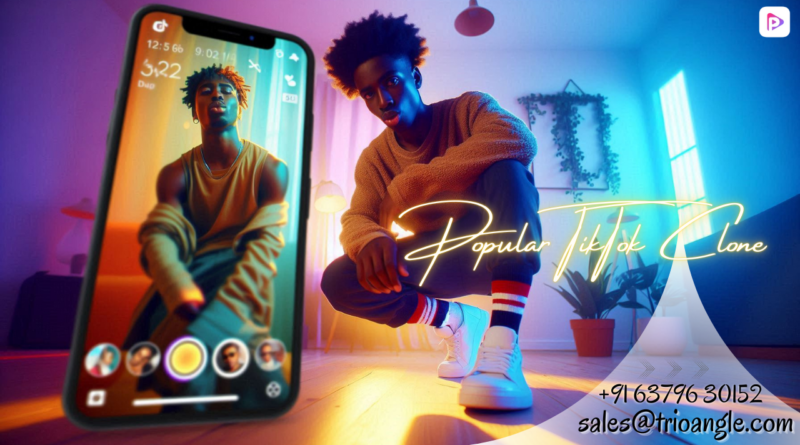Tiktok clone – I Built a TikTok Clone! Here is How to Get It!
In today’s digital age, social media and entertainment platforms have transformed how we connect, express ourselves, and consume content. Among these platforms, TikTok has emerged as a major player, captivating millions with its engaging short-form videos and innovative content creation tools
As a tech enthusiast and entrepreneur, I was inspired by TikTok’s success and I embarked on a journey to create my own TikTok clone app, offering similar features while adding unique twists to enhance user experience.
I’m eager to share how you can do this too!
Stay tuned!
Why Did I Build a TikTok Clone?
The main reason I decided to develop a TikTok clone script is due to the growing demand for short-form video-sharing platforms. With more people turning to video content for entertainment and information, there’s a huge opportunity for new players in the market.
Here are a few reasons why I chose to develop a TikTok app clone:
- Market Demand: TikTok has proven that short, engaging video content is here to stay. The demand for platforms that support this trend continues to grow.
- Monetization Potential: TikTok like app development provides several revenue opportunities, such as ads, sponsored content, and premium features.
- Custom Features: Using a pre-built TikTok script allows customization based on the audience’s preferences, providing a unique selling proposition.
Key Steps to Build a TikTok Clone App
Here, I will walk you through the key steps I followed to build a short-form video-sharing app like TikTok:
Conduct Market Research
Before starting app development, it’s important to understand the market you are entering. TikTok’s success comes from a deep understanding of its users and their needs, so I prioritized market research to gain insights into current trends, target audience preferences, and competitors.
Here’s what I focused on during market research:
- Analyze Competitors: I studied TikTok and similar platforms to identify their strengths and weaknesses. This analysis helped me identify areas where I could improve or customize features for my app.
- Survey Target Audience: I conducted surveys to understand what users liked about TikTok and what they wanted in a new app. This feedback was key in shaping the features and user experience of my TikTok app clone.
Define App Features
Once I gathered enough data from market research, I moved on to defining the core features that would make my TikTok like app competitive. These features are designed to provide a seamless and engaging user experience while offering something unique to differentiate my platform.
Here are the key features I integrated into my TikTok clone app development:
- Audio Catalog: A dedicated section where users can explore videos linked to specific audio tracks. This allows users to create videos synced with particular sounds.
- Video Creation Tools: Users can record, edit, and enhance videos using filters, effects, and background music, similar to TikTok.
- For You Page: An algorithm-based personalized feed displays trending and recommended content to keep users engaged.
- User Interaction: Features such as likes, comments, shares, and follow options are essential for creating a community-driven platform.
- Live Streaming: Users can broadcast live to their followers, adding an extra level of engagement.
- Location-Based Content: This feature allows users to discover videos based on geographical location and tag locations in the videos they share.
- Real-Time Analytics: After uploading a video, users can view real-time data on likes, comments, and other interactions. A graphical representation shows both broadcasters and viewers.
- Augmented Reality Filters: Enhance the user experience with AR filters that let users modify aspects like hair and eye color in their videos.
- Hashtag Discovery: This feature enables users to search for videos on specific topics using hashtags, making content discovery easier.
Choose the Right Technology Stack
Selecting the right technology stack was crucial to ensure scalability, performance, and flexibility. Since my video-sharing app like TikTok needed to support large-scale video uploads, editing features, and user interaction, I picked a tech stack that provided a solid foundation.
Here are some tech stacks that you can consider for your TikTok like app development:
- Android app development: Kotlin
- iOS app development: Swift
- Database management: SQL, MongoDB, Cassandra, DataStax
- Backend development: Node.js
- Cloud environment: Google Cloud Storage, AWS
- Payment services: Braintree, PayPal, Stripe
- Notifications: Google Cloud Messaging, Apple Push Notifications
Create the UI/UX Design
The design phase was one of the most crucial steps, as a successful TikTok clone app requires an intuitive, user-friendly interface. I focused on designing a seamless experience so users could easily navigate the app and create content without hassle.
Key design considerations I focused on:
- Simplicity: I used a swipe-up interface, similar to TikTok, allowing users to scroll through videos in full-screen mode with ease.
- Minimalism: I kept the layout clean and free of clutter, ensuring that the video content remains the center of attention.
- Responsive Design: I optimized the UI for all screen sizes, ensuring smooth performance on smartphones and tablets alike.
Develop and Test the App
With the design and technology stack in place, I began coding the backend of the app. During the development process, I followed agile methodologies, breaking the app into smaller, manageable features for easier development. After completing the coding phase, I thoroughly test the app to ensure flawless functionality.
During the testing phase, I focused on:
- Unit Testing: I conducted unit testing on individual components to ensure each feature worked independently.
- Beta Testing: I launched a beta version of the app to a select group of users for feedback, which helped identify usability issues and performance bugs.
- Performance Testing: I conducted stress tests to ensure the app could handle high user loads and large volumes of video content without any issues.
Launch and Deploy the App
After completing the development and testing phases, it was time to launch the app. I created a marketing and deployment strategy to ensure a smooth launch and reach the maximum number of users.
The deployment process I followed for my TikTok like app:
- App Store Optimization (ASO): I optimized the app’s listing on both the Apple App Store and Google Play Store with compelling descriptions, high-quality screenshots, and relevant keywords to improve visibility and attract users.
- Server Setup: I scaled up my cloud infrastructure to handle traffic and video uploads, ensuring the app was robust enough to withstand high user activity during the launch.
- Soft Launch: I conducted a soft launch in selected regions to gather initial feedback and address any last-minute bugs before the global launch.
Promote the App
The app launch is not complete without a solid marketing plan. I implemented a comprehensive marketing strategy to create buzz and drive downloads for my TikTok clone app.
Marketing strategies I used for my video-sharing app like TikTok:
- I ran targeted ads on social media platforms like Instagram, Facebook, and YouTube to encourage app downloads.
- They have partnered with content creators and influencers to promote the app and reach their audience.
- To encourage word-of-mouth promotion, I offered referral programs that rewarded users for bringing in new downloads
- I built an email list and sent newsletters to potential users to encourage downloads.
Wrapping Up
Building a TikTok clone app is a complex task that requires careful planning and technical expertise. By following these key steps, I successfully created a scalable, engaging, and competitive TikTok-like app that effectively engages users and stands out from the competition.
Whether you’re an entrepreneur looking to enter the entertainment market, these steps will help guide your process.
Embrace the opportunity and let your creativity shine in the dynamic world of video-sharing platforms!




